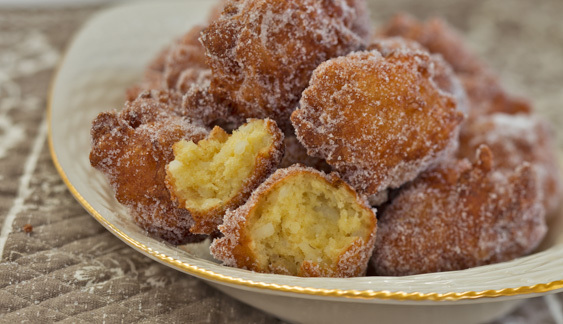Calas (Rice Beignets)

introduction
If crullers are Dutch, beignets French, and Berliners German, calas are most certainly Creole. But beyond what one expects to discover in a donut recipe (yeast, flour, butter, and eggs), calas contain cooked rice. The tradition of calas and their distinguishing ingredient landed in Louisiana on a boat from Ghana before Louisiana was even part of the United States! Like rice bread and other fading Southern rice-fed specialties, calas have struggled to remain in the cultural memory of their region. Yet after making them, we wonder why: this is one tasty little donut! Under their scratchy sugar cloak, calas have a fine, moist crumb and melting texture interrupted by the odd soft rice kernel. The magic of the rice in this formula, however, is not so much its textural contribution, but the unexpectedly enticing fermentation flavors the rice and yeast get up to in their time alone together, flavors that move throughout the batter when all elements are in place. And calas are easy to make! No rolling or cutting required—just shove batter off a spoon into hot fat and a couple minutes later, the calas are done.
-
-
2.5ounces (⅓ cup) Anson Mills Carolina Gold Rice
-
1½cups whole milk
-
½teaspoon fine sea salt
-
1ounce (2 tablespoons) unsalted European-style butter, cut into 2 or 3 pieces, room temperature
-
1½tablespoons hot tap water
-
¾teaspoon instant yeast
-
1tablespoon sugar, plus more for coating the beignets
-
2large eggs
-
⅛teaspoon ground nutmeg
-
1teaspoon vanilla extract
-
4.5ounces (1 cup) Anson Mills Fine Cloth Bolted Pastry Flour
-
Peanut oil for frying
-
-
The night before you plan to make the calas, turn the rice into a small bowl, add water to cover by about 1 inch, and let it soak it overnight in the refrigerator.
-
Drain the rice. In a small saucepan, bring the milk and ¼ teaspoon of the salt to a simmer over medium-high heat. Add the rice, stir well, and allow the mixture to return to a simmer. Turn down the heat to maintain a gentle but persistent bubbling, partially cover the pot, and cook, stirring occasionally, until the rice is tender, 15 to 17 minutes; stir more frequently near the end of cooking to ensure that the rice on the bottom of the pot does not scorch. The cooked rice will be thick and creamy and resemble rice pudding (fig. 2.1).
-
Off heat, vigorously stir the cooked rice with a spoon, breaking up the grains until the mixture resembles small-curd cottage cheese, and then stir in the butter until melted and fully incorporated. Transfer the rice to a medium mixing bowl and let cool for 5 minutes. Meanwhile, put the hot tap water in a small bowl, sprinkle the yeast over the top, and let stand until the yeast dissolves. Stir the dissolved yeast and the sugar into the rice. Cover the bowl and let the mixture rise at room temperature until doubled in volume, about 1 hour (fig. 3.1).
-
Beat the eggs in a small bowl, and then stir them into the rice mixture along with the nutmeg, vanilla, and remaining ¼ teaspoon salt (fig. 4.1). Add the flour and stir lightly with a rubber spatula to incorporate. Cover and let the batter rise at room temperature until once again doubled in volume, about 1 hour (fig. 4.2).
-
When the batter has almost doubled in volume, scoop about ½ cup of sugar into a small bowl for coating the calas. Set a wire rack on a rimmed baking sheet and line the rack with a triple thickness of paper toweling. Pour oil to a depth of about 1 ¼ inches into a medium heavy-bottomed saucepan and heat over medium-high heat until the oil registers 365 to 370 degrees on an instant-read or deep-fry thermometer. (Alternatively, if you have a Fry Daddy, feel free to use it.) Using a soupspoon, scoop up a generous tablespoon or so of batter and use a second soupspoon to push the batter off the spoon into the hot oil (don’t let the batter create a splash!). Repeat this process to fry four or five calas at a time, but do not overcrowd the pot. Fry the calas, turning them occasionally, until deeply browned on all sides (fig. 5.1), about 3 minutes total. Using a wire skimmer, transfer the calas to the prepared wire rack. Allow the oil to come back up to temperature before adding more batter. While you fry the next batch, toss the previous batch in the sugar until coated on all sides (fig. 5.2). Let cool slightly and serve.
-
-
2.1

-
-
-
3.1

-
-
-
4.1

-
4.2

-
-
-
5.1

-
5.2

-